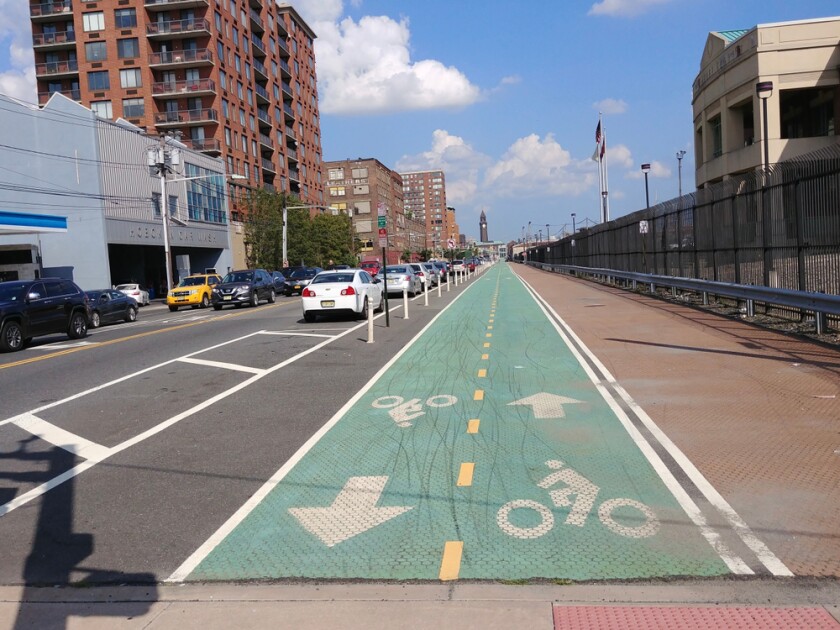This problem is on obvious display in Cobb County, the suburban behemoth of three-quarters of a million people just northwest of the city. In 2024, there were 14 pedestrian fatalities, a figure that exceeds the average of 12 for the pre-pandemic years. In Cobb County, the best available information is that while just 0.2 percent of all car crashes involve fatalities, the number jumps to 10 percent when the victim is a pedestrian. The primary suspect is the roads. “These aren’t accidents,” one Cobb engineer has said. “They are a result of road design.” And the most lethal flaw in the design of the county’s broad arterial highways is the absence of safe places to cross the street: Over 11 years, 58 percent of fatally injured pedestrians were crossing outside a crosswalk.
Cobb County, to its credit, has been devoting a chunk of its resources to finding how and why these crashes occur. It has uncovered some compelling and distressing facts, in cooperation with the Georgia Department of Transportation and as detailed by the Marietta Daily Journal and the newspaper’s excellent transportation reporter, Hunter Riggall.
Most of the fatal crashes occur at night. In 45 percent of the crashes, there were no streetlights to illuminate the pedestrians. More occur in winter, although the majority happen on clear roads. Driving under the influence accounted for a surprisingly small share of the fatal accidents, only about 3 percent, but distracted driving — mostly drivers using cellphones — is a worse problem. Over the decade from 2013 to 2022 in Cobb County, more than 40 percent of pedestrian deaths were thought to have involved distracted drivers.
All of this tracks pretty well with what we know about pedestrian crash deaths in the nation as a whole. In 2022, more pedestrians died on the road than in any of the preceding 40 years. From 2014 to 2024, pedestrian deaths rose seven times faster than the national population. The national numbers from 2024 look a little better, but as my Governing colleague Jared Brey recently reported, most of the 2024 decline took place in California. If you take California out, there really isn’t much improvement to be found.
There are a few relatively plausible explanations for the increase in pedestrian deaths over a prolonged period. Roads weren’t as crowded with cars during the pandemic, possibly leading drivers to act more recklessly. Traffic-law enforcement declined, especially after the emphasis on police excesses that followed the George Floyd murder in 2020. And vehicles have gradually gotten bigger; the Governors Highway Safety Association reported that light trucks were involved in 52 percent of pedestrian deaths nationwide.
ALL OF THESE FACTORS MAY HAVE BEEN IN PLACE, to one extent or another, in the Washington, D.C., region. Between 2015 and 2018, car crashes killed one out of 100,000 residents in the area. By 2024, the rate had doubled. This happened during a drastic reduction in police issuance of speeding tickets: In 2019, more than 10,000 of these tickets were given out to lawless drivers; in 2024, that number had been cut by more than half. There were 15 hit-and-run pedestrian fatalities in D.C. in 2024, according to the Washington Post; no driver was charged in any of them.
The District’s transportation director, Sharon Kershbaum, argued that most of these deaths had to do with human misconduct, not faulty road design. Nearly 80 percent of pedestrian deaths, she told the Post, “were tied to reckless and anti-social behavior.” In making that assertion, Kershbaum was aligning herself with the nation’s most outspoken — and iconoclastic — student of pedestrian fatalities, Greg Shill, a law professor at the University of Iowa.
Shill argues forcefully that pedestrians — and motorists — die on the roads mostly because of driver malfeasance, not badly designed highways. His statistics assert that roughly half of driver deaths occur when the driver fails to wear a seatbelt and that about a third of road fatalities are tied to drunk driving. “Design,” he insists, “is not responsive to these problems.” What’s needed, Shill believes, is more enforcement — more tickets issued for moving violations, more speed cameras, more crackdowns on red-light running, more vigilance on the part of the authorities in general.
Somewhat surprisingly, Shill focuses much of his criticism on the highway safety movement, and more specifically on the Vision Zero traffic control programs that this movement has encouraged localities to implement in recent years. Shill disparages the Vision Zero approach as “street design essentialism,” a belief that the nation can design its way out of the thousands of needless fatalities that occur on streets and highways every year. “Street design, which seeks to make the average driver more conscientious,” Shill has written, “does nothing to target the anti-social behavior of outliers.” Design solutions, he adds, “are increasingly expensive, take forever, and fail to address the problem in many settings.”
Shill’s most vehement arguments are against the decisions of some city officials to remove speed cameras from disadvantaged neighborhoods on the grounds that they discriminate against the poor. “The fact that a neighborhood is disadvantaged,” he writes, “is [no] reason to deprive its children of protection rather than to mail a ticket to those passing through who would strike them.”
The coalition that Shill derides as the design essentialist movement has taken issue with most of what he says. And Shill himself concedes that design enhancements such as making roads less conducive to speeding are worth implementing. But he insists that “it makes no sense to make design functionally the exclusive means to the end of safety.” And leaving these assertions aside, the fact remains that Vision Zero has had relatively little success in curbing pedestrian fatalities so far.
SO WHAT ARE LOCALITIES DOING ABOUT ALL THIS? Cobb County, following up on its research, has instituted a new traffic calming program, in which communities can petition to lower their speed limits. It has established a Comprehensive Safety Action Plan and is considering improvements including pedestrian refuge islands, crosswalk enhancements and curb extensions.
But major changes to the county’s transportation system are not going to be easy to enact. Last year, the county asked voters to approve a new sales tax to pay for further pedestrian infrastructure and additional traffic signals, medians and turn lanes. It was rejected by 62 percent of the voters.
And enhanced speed cameras, Shill’s first priority, may be an equally tough sell in suburban territory such as Cobb County and places like it all over the country. In Virginia, where two girls were killed in suburban Fairfax County by a driver going 81 mph just outside a school zone, a state legislator proposed new money for more speed cameras. The proposal failed to pass. “Nobody has the appetite” for it, the sponsor said. The only significant measure that got through this year was a bill to impose speed-limiting equipment on repeat speeding offenders.
The reality appears to be that in suburban America, where most of the pedestrian fatalities take place, there is still a strong backlash against paying for more traffic surveillance and dealing with its regulations. It may be a long time before Greg Shill gets the kind of enforcement he is pleading for. Localities are talking more about the problem, but are proving very slow to do much about it.
In the meantime, the most humane option for Cobb County might still be to build a few more crosswalks.
Governing’s opinion columns reflect the views of their authors and not necessarily those of Governing’s editors or management.
Related Articles
-
Future in Context














